

Stonehenge: Facts & Theories About Mysterious Monument. Stonehenge is a massive stone monument located on a chalky plain north of the modern-day city of Salisbury, England.
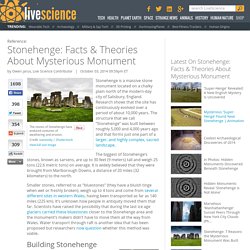
Research shows that the site has continuously evolved over a period of about 10,000 years. The structure that we call “Stonehenge” was built between roughly 5,000 and 4,000 years ago and that forms just one part of a larger, and highly complex, sacred landscape. The biggest of Stonehenge’s stones, known as sarsens, are up to 30 feet (9 meters) tall and weigh 25 tons (22.6 metric tons) on average. It is widely believed that they were brought from Marlborough Downs, a distance of 20 miles (32 kilometers) to the north. Smaller stones, referred to as “bluestones” (they have a bluish tinge when wet or freshly broken), weigh up to 4 tons and come from several different sites in western Wales, having been transported as far as 140 miles (225 km). Building Stonehenge Hunting played an important role in the area. Stonehenge at sunrise.Credit: Simon Wyatt 0 of 10 questions complete.
Vitrified fort. It is not clear why or how the walls were subjected to vitrification.
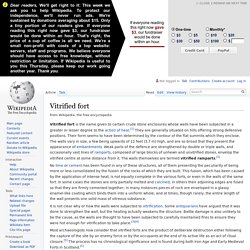
Some antiquarians have argued that it was done to strengthen the wall, but the heating actually weakens the structure. Battle damage is also unlikely to be the cause, as the walls are thought to have been subjected to carefully maintained fires to ensure they were hot enough for vitrification to take place.[3][4] Most archaeologists now consider that vitrified forts are the product of deliberate destruction either following the capture of the site by an enemy force or by the occupants at the end of its active life as an act of ritual closure.[5] The process has no chronological significance and is found during both Iron Age and Early Medieval Forts in Scotland.[5] Appearance in Media[edit] Dorset culture.
The Dorset culture (also called the Dorset Tradition ) was a Paleo-Eskimo culture (500 BCE–1500 CE) that preceded the Inuit culture in Arctic North America .
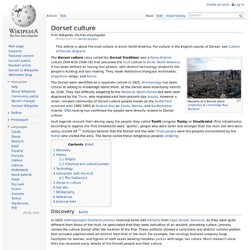
It has been defined as having four phases, with distinct technology related to the people's hunting and tool making. They made distinctive triangular end-blades, soapstone lamps, and burins . The Dorset were identified as a separate culture in 1925. Archaeology has been critical to adding to knowledge about them, as the Dorset were essentially extinct by 1500. They had difficulty adapting to the Medieval Warm Period and were later displaced by the Thule , who migrated east from present-day Alaska . Inuit legends recount their driving away the people they called Tuniit (singular Tuniq ) or Sivullirmiut (First Inhabitants). Discovery [ edit ] In 1925 anthropologist Diamond Jenness received some odd artifacts from Cape Dorset, Nunavut .
Genetic history of the British Isles. The genetic history of the British Isles is the subject of research within the larger field of human population genetics .
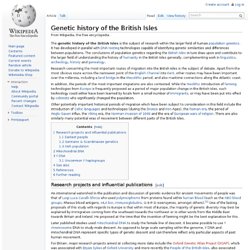
It has developed in parallel with DNA testing technologies capable of identifying genetic similarities and differences between populations. Prehistoric Britain. Bronze Age Britain. Bronze Age Britain refers to the period of British history that spanned from c. 2,500 until c. 800 BC. [ 1 ] Lasting for approximately 1700 years, it was preceded by the era of Neolithic Britain and was in turn followed by the era of Iron Age Britain .
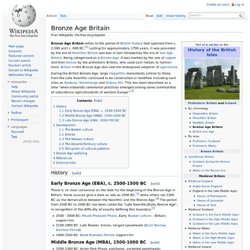
Being categorised as a Bronze Age , it was marked by the use of copper and then bronze by the prehistoric Britons, who used such metals to fashion tools. Britain in the Bronze Age also saw the widespread adoption of agriculture . During the British Bronze Age, large megalithic monuments similar to those from the Late Neolithic continued to be constructed or modified, including such sites as Avebury , Stonehenge and Silbury Hill . This has been described as a time "when elaborate ceremonial practices emerged among some communities of subsistence agriculturalists of western Europe". [ 2 ] History [ edit ] Early Bronze Age (EBA), c. 2500-1500 BC [ edit ] Boudica. Boudica ( / ˈ b uː d ɨ k ə / ; alternative spelling: Boudicca ), also known as Boadicea / b oʊ d ɨ ˈ s iː ə / and known in Welsh as Buddug [ˈbɨ̞ðɨ̞ɡ] [ 1 ] (d.

AD 60 or 61) was queen of the British Iceni tribe who led an uprising against the occupying forces of the Roman Empire . Boudica's husband Prasutagus , ruler of the Iceni tribe, who had ruled as a nominally independent ally of Rome, left his kingdom jointly to his daughters and the Roman Emperor in his will; however, when he died, his will was ignored —the kingdom was annexed as if conquered, Boudica was flogged , her daughters were raped, and Roman financiers called in their loans.
The crisis caused the Emperor Nero to consider withdrawing all Roman forces from Britain, but Suetonius' eventual victory over Boudica re-secured Roman control of the province. Boudica then either killed herself, so she would not be captured, or fell ill and died—the extant sources, Tacitus [ 6 ] and Cassius Dio , [ 7 ] differ.